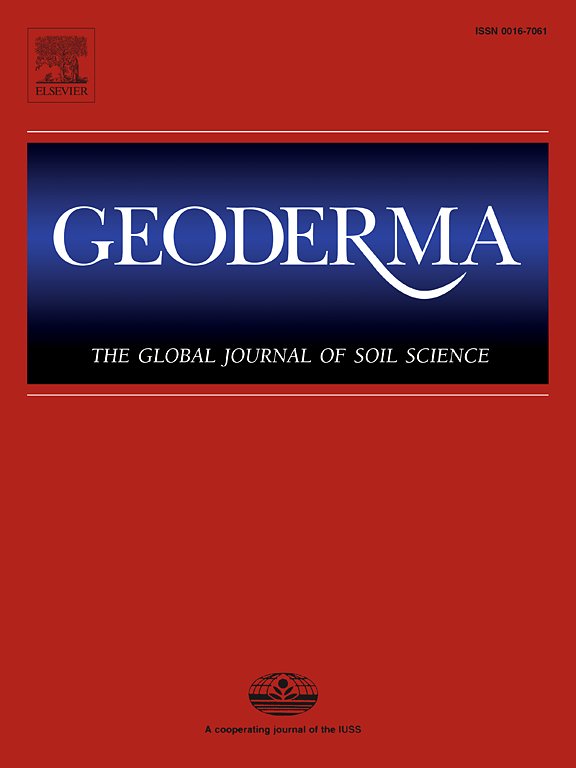Suppression of hydrolytic enzyme activities by short-term aeration of periodically anoxic soils: Evidence from upland ecosystems
IF 5.6
1区 农林科学
Q1 SOIL SCIENCE
引用次数: 0
Abstract
Land-use change and duration of agricultural practice cause shifts in the soil physical structure and porosity. These changes, in turn, may hamper soil aeration, restrict gas exchange, and therefore, cause establishment of anoxic conditions in upland soils. Such periodic fluctuations of aeration control the activity of microbial extracellular hydrolytic enzymes. Earlier studies revealed a clear suppression of key hydrolytic enzymes due to a short-term aeration (i.e., oxygen exposure) of established anoxic ecosystems such as rice paddies. However, it remains unclear whether the suppression also occurs in upland soils with periodic anoxicity. This key gap was addressed by measuring the kinetic parameters and in situ activities of hydrolytic β-glucosidases and acid phosphatases under oxic and anoxic conditions in forest, grassland, and cropland mineral soil after 3–5 days of anoxic pre-incubation. Short-term (2 h) aeration suppressed β-glucosidase and acid phosphatase activities by up to two times as compared with activities under anoxic conditions. The suppressive effects of aeration on the maximum reaction rate of enzymatic activity (Vmax) were more pronounced in the cropland (by 1.6–2.4 times) than in the forest (by 1.3–1.7 times) soil. Our findings indicate the importance of fluctuations in redox conditions in the soil organic matter transformation catalyzed by hydrolytic enzymes, particularly in scenarios where the frequency and/or severity of flooding events increase due to changes in land use and/or climatic conditions. The mechanism of the suppression of hydrolytic enzyme activities has been demonstrated to be sustainable in lowland and upland ecosystems, yet further studies are required to elucidate the biogeochemical basis for this phenomenon.
周期性缺氧土壤短期曝气对水解酶活性的抑制:来自山地生态系统的证据
土地利用变化和农业实践持续时间引起土壤物理结构和孔隙度的变化。这些变化,反过来,可能阻碍土壤通气,限制气体交换,因此,造成缺氧条件的建立在旱地土壤。这种曝气的周期性波动控制着微生物胞外水解酶的活性。早期的研究表明,由于建立的缺氧生态系统(如稻田)的短期曝气(即氧气暴露),关键水解酶明显受到抑制。然而,目前尚不清楚这种抑制是否也发生在周期性缺氧的旱地土壤中。通过对森林、草地和农田矿质土壤在缺氧和缺氧条件下水解β-葡萄糖苷酶和酸性磷酸酶的动力学参数和原位活性的测量,在3-5天的缺氧预孵育后,解决了这一关键空白。短期(2小时)曝气可抑制β-葡萄糖苷酶和酸性磷酸酶的活性,其活性是缺氧条件下的两倍。曝气对土壤酶活性最大反应速率(Vmax)的抑制作用在农田(1.6 ~ 2.4倍)比森林(1.3 ~ 1.7倍)更为显著。我们的研究结果表明,氧化还原条件的波动在水解酶催化的土壤有机质转化中的重要性,特别是在由于土地利用和/或气候条件的变化而导致洪水事件的频率和/或严重程度增加的情况下。在低地和高地生态系统中,水解酶活性的抑制机制已被证明是可持续的,但这一现象的生物地球化学基础还有待进一步研究。
本文章由计算机程序翻译,如有差异,请以英文原文为准。
求助全文
约1分钟内获得全文
求助全文
来源期刊

Geoderma
农林科学-土壤科学
CiteScore
11.80
自引率
6.60%
发文量
597
审稿时长
58 days
期刊介绍:
Geoderma - the global journal of soil science - welcomes authors, readers and soil research from all parts of the world, encourages worldwide soil studies, and embraces all aspects of soil science and its associated pedagogy. The journal particularly welcomes interdisciplinary work focusing on dynamic soil processes and functions across space and time.
 求助内容:
求助内容: 应助结果提醒方式:
应助结果提醒方式:


